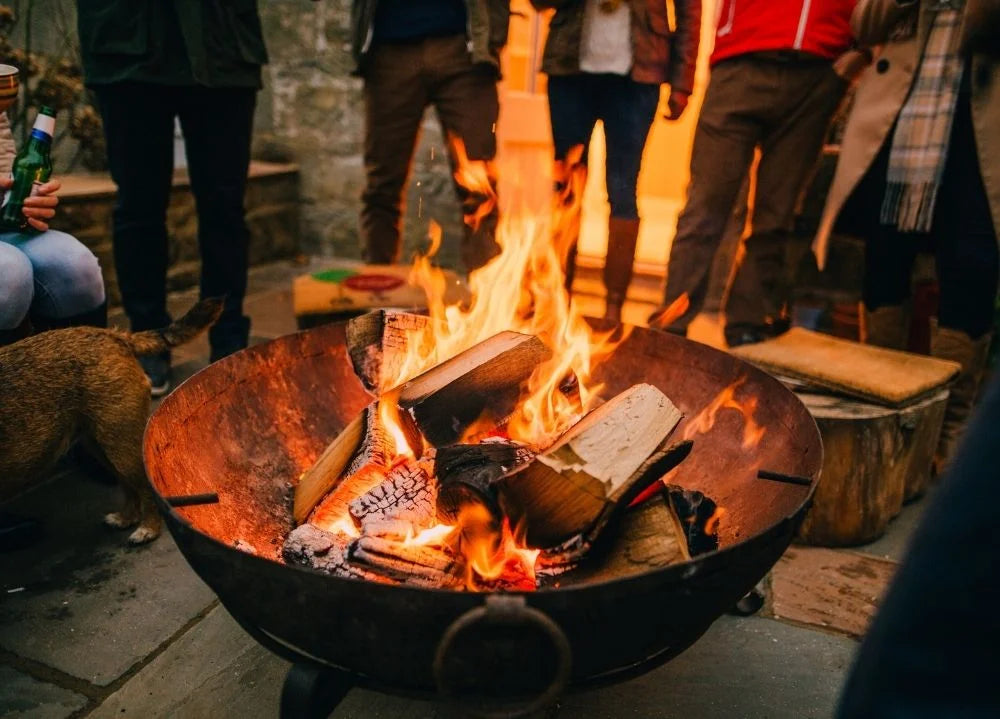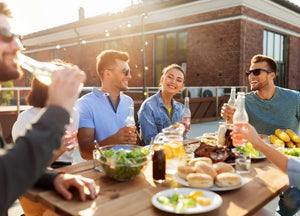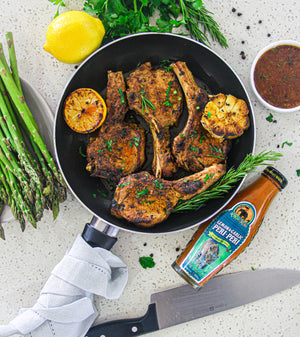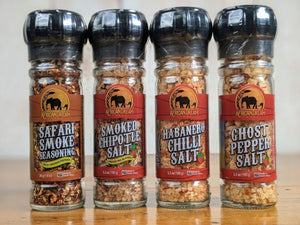South African Braai: How to Barbecue Like a South African
Aug 25, 2022
South Africans share a love of braaing that is prevalent across all cultures. It has even spread to other parts of the globe, causing an international buzz surrounding this South African way of cooking. It even has its own show! In fact, if you ever step foot in Cape town or any other South African city, you’ll be hard-pressed to find South Africans not braaing.

So, as incredible as braaing sounds, what actually does it mean? Moreover, what do you need to braai like South Africans? Keep on reading, and you’ll discover all you need to know about the art of the South African braai.
What Is a South African Barbecue Called?
South African barbecue, also known as Braai, has no equivalent in the world. The word ‘braai’ originated from the Dutch word ‘braden’ which means to roast or bbq. This happened when South Africa was an old dutch colony, and over the years, ‘braden’ transformed into the Afrikaans ‘braai’.
Still, don’t go thinking that braai is only found in South Africa. This mouth-watering barbequing technique is also found in other African countries like Botswana, Namibia, Malawi, Swaziland, Zimbabwe, Zambia, and Lesotho.
SEE ALSO: What does BBQ Stand For?
What Is a Braai in South Africa?
So, now that you know that South African barbeque is called braai. Still, what exactly is braai?
Well, quite simply, braai is a way to cook and roast meat using aromatic wood. Braai can also be used to refer to a long social gathering with a braai taking place in the background. Just think of your traditional American barbeque, and replace the gas/electrical grill with a wood fire pit.
The beauty of braai comes from making a wood fire and then tending that fire meticulously to produce the most succulent and aromatic dishes. Add to that a few funny stories and a glass of white wine, beer, or the classic South African drink – brandy and coke, and you’ve got yourself the perfect summer day.
Do You Have to Use Wood in South African Braai?
Nothing brings out the best flavors of meat than the right type of wood. That’s exactly why using wood is considered the traditional and most authentic way of braaing. Yes, sometimes South Africans braai using charcoal instead of wood, but that’s only for convenience, and some see this as cheating.
Still, beware that braai can go on for a long time. It’s not a simple affair that takes a couple of hours. There’s even a designated braai master whose job is tending the fire and watching the meat.

However, if you think of braai as more of a social gathering and less of a place to eat, you’ll end up having the best time of your life. That’s certainly why the locals throw a braai every chance they get.

Time and Place for South African Braai
Birthdays, graduations, engagements, and national holidays serve as perfect occasions to host a braai with your family and friends. There’s even a specific day of the year in South Africa that’s designated for braaing. It’s officially called Heritage Day, but everyone refers to it as Braai Day.
Oh, and by the way, even if you don’t have any occasions lined up, you can still braai on a lazy Sunday afternoon or any other day you want. Honestly, braaing can be done any place, any time, provided you have the right tools, and you know what you’re doing.
Types of South African Braai
Generally, there are two types of South African Braai, and the host will always let his guests know beforehand which type it is.
The first is the “Chop ‘n Drop”. This is a casual braai in which the guests need to bring their own meat and drinks. However, the host will provide everything else, from salads and snacks to grills and fuel.
On the other hand, in a “Bring ‘n Braai,” the host will only provide you with a fire and gathering place. All the other things have to be brought by the guests.
So, in a “Bring ‘n Braai,” you won’t be getting things for yourself. Rather, you’ll be contributing with various items that all guests will enjoy. Accordingly, in a “Bring’ n braai,” you should provide a type of meat, one side dish or salad, and any kind of beverage. You can go the extra mile and get dessert as well, but make sure to get enough for all the other guests.
What Do You Need for a South African Braai?
If you’re going to be hosting your own South African braai, you need to have a couple of things on hand. The trick to braai lies in possessing the right equipment. So, let’s take a look at the essentials of traditional braai and take your first step at becoming a braai master.
SEE ALSO: How to Grill Like a Pro
Grill/Fire Pit
You guessed it. Having a good wood-fire grill is critical for South African braai. It fits perfectly in designated indoor braai areas, and usually, braai masters have more than one grill going to cook various dishes. However, if you’re going to be braaing outside under the blue sky, then an open pit-fire will be just as great.
Wood
As you know by now, wood is indispensable for South African braai. Without it, you can’t achieve that wonderful smoky taste that’ll leave you licking your fingers.
Nevertheless, you can’t go using any type of wood you find lying about. Certain types of wood will make or break your braai, so you have to make sure you choose the right one.
Some of the approved wood varieties for braai include:
- Rooikrans, aka Red Garland: This wood burns quite fast and leaves you with excellent, lasting coals.
- Kameeldoring, aka camel thorn: Kameeldorning burns slowly, but it burns hot.
- Wingerd, aka vine wood: This wood is great for starting fires and adding aromas and flavors to the dishes. However, since it burns very fast, it won’t leave you with lasting coals.
- Applewood: Applewood is perfect for giving your meat a sweet, aromatic flavor. However, it can be hard to come by, so look for another wood if that’s the case for you.
- Mopani: If you want to get scorching hot coals that’ll last for a long time, then Mopani should be your go-to. While this wood can be hard to get burning, once it gets going, it’ll produce intensely-hot coals in no time at all.
- Sekelbos: Similar to Mopani, Sekelbos is dry and hardy wood. Accordingly, it’ll burn for a long time with intense heat. And since it has natural oils within it, it’ll give you braai meat an amazing smoking flavor and aroma that’s to die for.
- Black Wattle: This wood is considered an invasive species, so using it for braai is greatly encouraged. It can produce hit, long-lasting fires, which makes them perfect for braaing.
- Pinewood: If pinewood is easily available where you’re from, then you can use it for starting your braai fire. However, pinewood can’t be the main firewood of your braai, so look for another wood to go with it.
TIP: You can use charcoal if you’re pressed for time. Although, your braai meat won’t turn out as good as it could be. However, charcoal beats gas any day, which is a BIG no-no in South African braai.
Cooking Utensils and Other Equipment
It goes without saying that you’ll need some long grill tongs since fire will be involved. A sharp and sturdy cleaver is also a must to cut up and divide your meat. Additionally, buy yourself some long skewers, a spray bottle, as well as a large grill basket. You’ll also need a cured or well-greased grill to prevent your food from sticking to your grill grates like a piece of gum.
And of course, to get the fire started in the first place, you’ll need some matches and firelighters. You can also make do with a gas torch but use it carefully.
Most importantly, whether you’re cooking indoors or outdoors, make sure you have a fire extinguisher at hand. If left unmonitored, braai fires, especially in open pits, can accidentally get out of control. So it’s best you know how to use a fire extinguisher before attempting your first braai.
TIP: You can prevent your meat from sticking to the grill by rubbing half an onion all over the grill.
Braai Customs and Etiquette
Most South Africans know the customs and etiquette of a braai. However, for others who weren’t raised in South African households, getting things right in a braai can be kind of challenging. Accordingly, you’ll find below the do’s and don’t of a South African braai. So, make sure to memorize them before your next braai.

Things to Do
As the Host
- As a host, you don’t have to do much but set up and make sure your guests are enjoying themselves.
- However, as a pitmaster, you need to make sure you get the best quality meat and ingredients. You also have to marinate the meat beforehand. A typical marinade often includes olive oil, lemon juice, coriander seeds, curry powder, as well as salt and black pepper. Or, to make life a lot easier, just grab some Southern Braai Sauce and you are good to go!
- Finally, you should prepare your grill and firewood. Make sure you have tinder, kindling, and large logs to last you through the whole event. And needless to say, you have the essential role of starting and maintaining the fire.
TIP: Try to build a fire on one side of the grill, and once the hot coals form, move them to where you’ll be cooking.
As a Guest
- When going to a braai, it’s a good idea to bring flowers or a small gift to thank your host. You should also ask the host what you need to bring and actually bring it when you come. And, of course, bringing extras will never hurt.
- Keeping the pitmaster company is good manners, and so is complimenting them for their marinade and grilling technique. You should also top up their drink and help them set and clear the table.
Things to Avoid
As the Host
- If you want to do justice to the South African tradition, then you should never use a gas grill. Moreover, you shouldn’t use paraffin or lighter fluids to start the fire. Matches or lighters will be more than enough.
As a Guest
- There’s an Afrikaans saying that goes: “Jy krap nie aan ‘n ander man se vuur nie”. This translates into “Don’t mess around with another man’s fire.”
Accordingly, if you’re ever invited to a braai, you should never do a thing as rude as giving advice to the pitmaster or trying to take over his place. Remember this and remember it well: backseat braaing is never welcomed or allowed, so don’t get your own tongs and start meddling.
Obviously, you should never complain about the music or bring extra people without informing your host first.
And as a final piece of advice, don’t arrive hungry if you can. Waiting for the fire to generate the required heat takes time, and so does waiting for the meat to cook. So, don’t just stand in a corner waiting for the food like a loner. Spread out and socialize with the other guests, and swap stories and enjoy yourself until the food is ready.
Snacks and Grilling Options in a Braai
Boerewors, Afrikaans for farmer’s sausage, is a traditional sausage typically served in braais. It’s made out of pork and beef mixture or just beef that is coarsely ground for a chunky texture.
“Farmer’s sausage” is seasoned with vinegar, salt, coriander, cloves, nutmeg, black pepper, and other wonderful spices. Then, they’re rolled into a coil, grilled as is, and served with bread and caramelized onions.

Biltong and Droewors are other trademarks of South African cuisine that are commonly seen at a braai. Biltong and Droewors are types of dried, cured meat that is specially seasoned and served as snacks in a braai. They’re typically made out of beef, but occasionally they can be made of ostrich, impala, or game meat.
Lamb chops from the Karoo region are another favorite in braais. The lamb is marinated with garlic, thyme, and rosemary and then tossed on the grill until the meat gets an appetizing herb-like aroma.
Similarly, ostrich steaks are another local favorite, though some foreigners may be surprised at the dish’s origin. Thankfully, traditional steaks, chicken kebabs, and grilled seafood are available for the less adventurous individuals, though chicken is usually considered a salad in the eyes of braai purists.
Finally, you can find the popular Roosterkoek in any braai. This “grill cake” is simply the traditional bread served at braais alongside the various meat dishes. It consists of bread dough cooked over the grill until they turn golden.

You can also find other side dishes in braais like mashed potatoes, crayfish tails, pap (maize porridge), chips’ n dips, and good ol’ Braaibroodjie, which is basically a grilled sandwich with tomatoes and cheddar cheese.
FAQs
What Food Is South Africa Known for?
South Africa is known for a variety of food, including dishes like sosatie, vetkoek, mealie pap, biltong, droëwors, and more. However, dishes served in braais are probably the most famous (and most delicious).
How to Pronounce Braai
Braai is pronounced like bye, but add an “r” after the “b.”
Can You Braai in Rainy Weather?
Absolutely. Braaiing isn’t just for the warm weather. In fact, many South Africans will braai rain or shine, unlike American BBQs. As long as you’ve got a covered patio, this important cultural event can occur in any weather.
What Is Heritage Day?
Heritage day is a national holiday in South Africa that falls on September 24th. It’s meant to celebrate the cultural diversity of South Africa, and many South Africans take to braaing this day.
Final Words
Good food is easy to come by nowadays, but there’s nothing quite like meat cooked over a wood fire pit. Honestly, South African braai isn’t just a meal; it’s a whole experience.
Though a braai can have some strict rules, the event itself is quite lax and enjoyable, and you’re bound to taste the best barbeque you’ve ever had in your life there.




